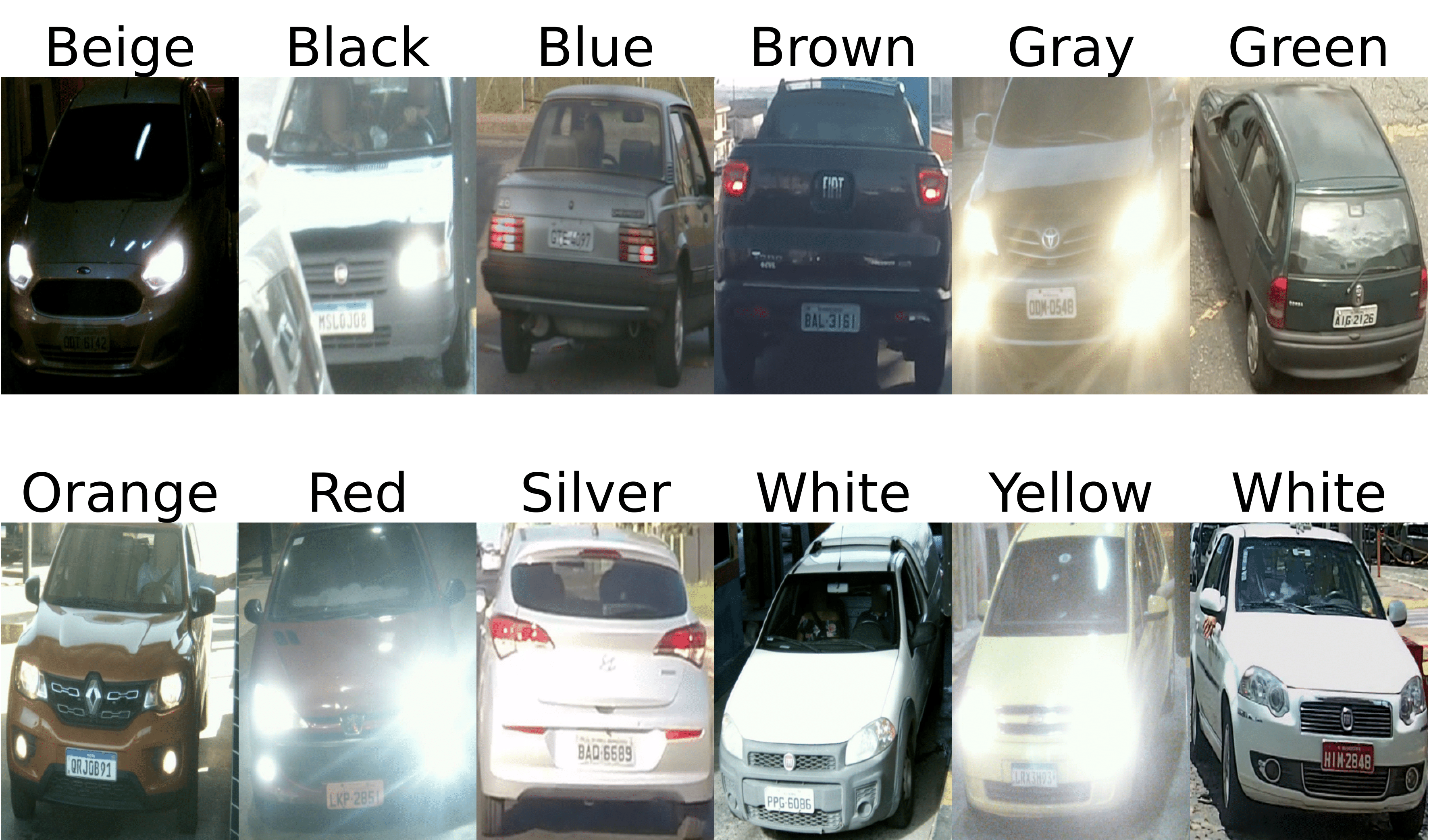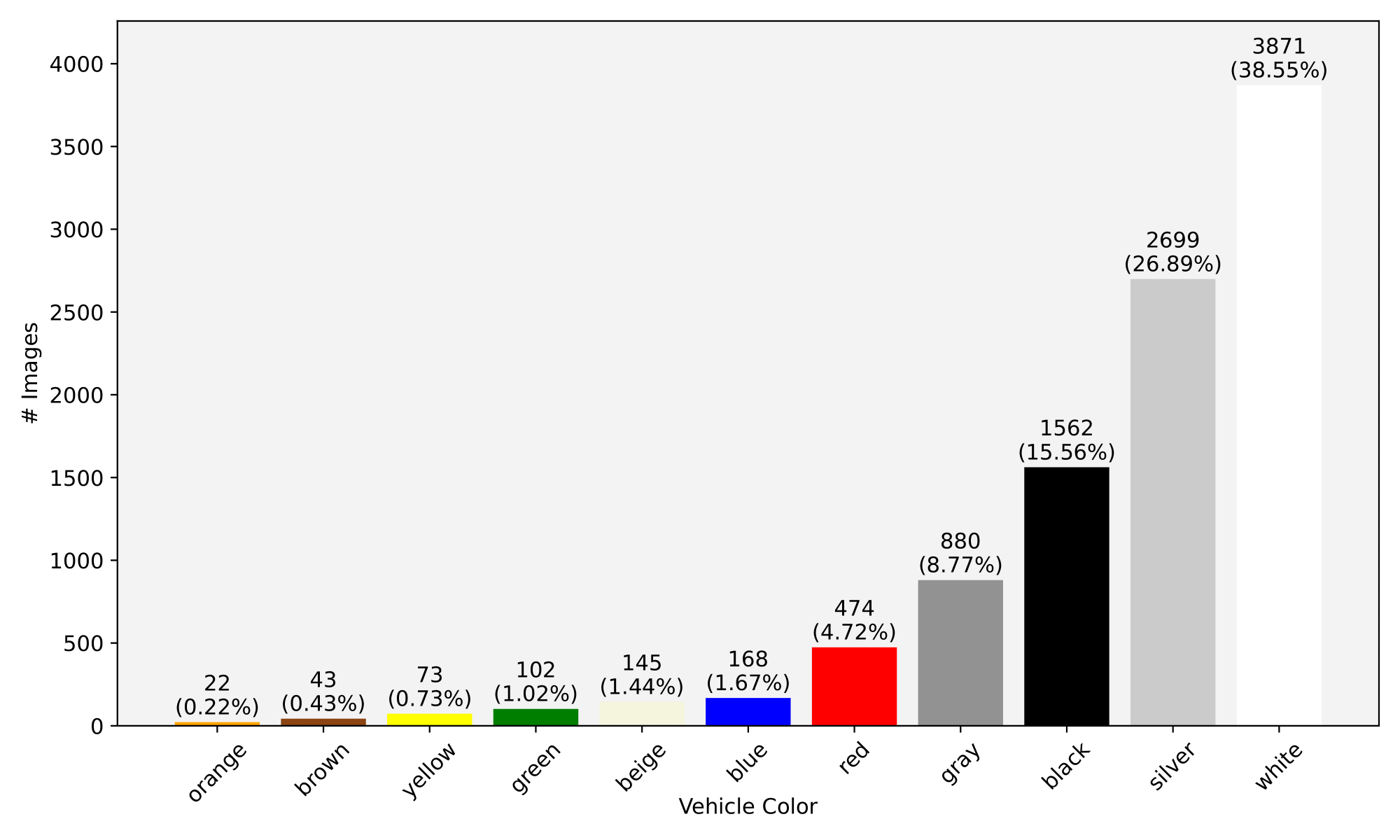The UFPR Vehicle Color Recognition (UFPR-VCR) dataset was created to tackle vehicle color recognition in more complex scenarios than those explored in previous studies. The dataset's construction and initial results from experiments using deep learning models are detailed in our paper Toward Enhancing Vehicle Color Recognition in Adverse Conditions: A Dataset and Benchmark [PDF].
The UFPR-VCR dataset contains 10,039 images of 9,502 distinct vehicles across various categories, including cars, vans, buses, and trucks. The images represent a wide range of real-world conditions, such as frontal and rear views, partial occlusions, diverse lighting situations, and nighttime scenes. Examples of these images are shown in Fig. 1.
Fig. 1. Examples of images from the UFPR-VCR dataset, with the corresponding vehicle color annotations displayed above each image.The dataset's images were sourced from six public datasets collected in Brazil, originally created for automatic license plate recognition (ALPR). These datasets include OpenALPR-BR, RodoSol-ALPR, SSIG-SegPlate, UFOP, UFPR-ALPR, and Vehicle-Rear. The original images underwent preprocessing and selection procedures to standardize them and identify those suitable for vehicle color recognition.
The images cover eleven distinct vehicle colors: beige, black, blue, brown, gray, green, orange, red, silver, white, and yellow. The class distribution of the dataset is presented in Fig. 2. Annotations for over 90% of the vehicles were validated using information obtained from the corresponding license plate annotations in the original datasets.
Fig. 2. Distribution of vehicle colors in the UFPR-VCR dataset.Regarding privacy concerns, it is important to note that since the data originates from datasets acquired in Brazil, the license plates are associated with the vehicles only, and no public information about vehicle drivers or owners is available.
As we are not the creators of the original ALPR datasets, we have decided to grant access to the images we have generated from these datasets upon request, subject to the signing of a licensing agreement. In essence, the UFPR-VCR dataset is released for academic research only and is free to researchers from educational or research institutes for non-commercial purposes.
To access the dataset, please review the license agreement, sign it, and return it to the first author at (gelima@inf.ufpr.br). Make sure to send your request from a valid university email account (e.g., .edu, .ac, or similar). You can expect to receive a download link within 1-5 business days.
Please note that failure to follow these instructions may result in no response.
If you use the UFPR-VCR dataset in your research, please cite our paper:
- G. E. Lima, R. Laroca, E. Santos, E. Nascimento Jr., D. Menotti, "Toward Enhancing Vehicle Color Recognition in Adverse Conditions: A Dataset and Benchmark," in Conference on Graphics, Patterns and Images (SIBGRAPI), pp. 1-6, Sept. 2024. [arXiv]
@inproceedings{lima2024toward,
title = {Toward Enhancing Vehicle Color Recognition in Adverse Conditions: A Dataset and Benchmark},
author = {G. E. {Lima} and R. {Laroca} and E. {Santos} and E. {Nascimento Jr.} and D. {Menotti}},
year = {2024},
month = {Sept},
booktitle = {Conference on Graphics, Patterns and Images (SIBGRAPI)},
volume = {},
number = {},
pages = {1-6},
doi = {},
issn = {1530-1834},
}
A list of all our papers on vehicle identification can be seen here.
For any questions or comments, please contact Gabriel E. Lima (gelima@inf.ufpr.br).

